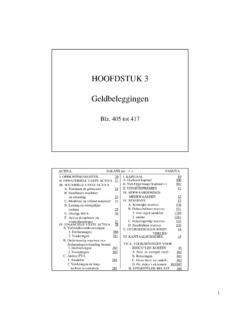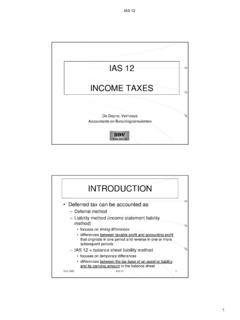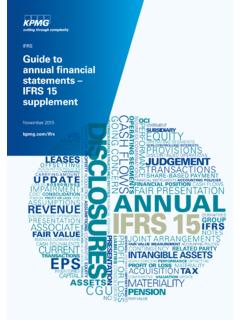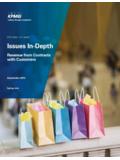Transcription of IFRS 3 BUSINESS COMBINATIONS - ddv.be
1 ifrs 3 BUSINESS COMBINATIONSJan VERHOEYED ocent Hogeschool GentGastprofessor Universiteit GentLid Commissie voor Boekhoudkundige NormenLid Supervisory Board EFRAG3-7-2005 ifrs 32 SIGNIFICANT CHANGESIFRS 313-7-2005 ifrs 33 ACCOUNTNG TREATMENT SECURITIES ACQUISITIONSThe ifrs framework for dealing with equity and other securities investments is outlined as follows:Percentage ownership Accounting treatmentIFRS ReferenceLess than 20%Fair valueIAS 39 Between 20-50%Equity accountingIAS 28 More than 50%ConsolidationIAS 27 OtherJoint venturesIAS 31 BUSINESS combinationsIFRS 33-7-2005 ifrs 34 OBJECTIVE (1) Financial reporting by an entity when it undertakes a BUSINESS combination Applying the purchase method The acquirer recognises the acquiree sidentifiable assets, liabilities and contingent liabilities ( voorwaardelijke activa ) at their fair valuesat the acquisition date Recognises goodwill, which is subsequently tested for impairment rather than amortisedIFRS 323-7-2005 ifrs 35 DEFINITIONS Acquisition date: the date on which the acquirer effectively obtains controlof the acquiree Agreement date.
2 The date that a substantive agreement between the combining parties is reached and, in the case of publicly listed entities, announced to the public in the case of a hostile takeover, the earliest date that a substantive agreement between the combining parties is reached is the date that a sufficient number of the acquiree s owners have accepted the acquirer s offer for the acquirer to obtain control of the acquiree3-7-2005 ifrs 36 DEFINITIONS BUSINESS : an integrated (!) set of activities and assets conducted and managed for the purpose of providing: a return to investors or lower costs or other economic benefits directly and proportionately to policyholders or participants a BUSINESS generally consists of inputs, processes applied to those inputs, and resulting outputs that are, or will be, used to generate revenues if goodwill is present in a transferred set of activities and assets, the transferred set shall be presumed to be a businessIFRS 333-7-2005 ifrs 37 DEFINITIONS BUSINESS combination : the bringing together of separate entities or businessesinto one reporting entity BUSINESS combination involving entitiesor businessesunder common control.
3 A BUSINESS combination in which all of the combining entities or businesses ultimately are controlled by the same party or parties both beforeand afterthe combination , and that control is not transitory3-7-2005 ifrs 38 DEFINITIONS Contingent liability (IAS 37) a possible obligation that arises from past events and whose existence will be confirmed only by the occurrence or non-occurrence of one or more uncertain future events not wholly within the control of the entity or a present obligation that arises from past events but is not recognised because: it is not probable that an outflow of resources embodying economic benefits will be required to settle the obligation or the amount of the obligation cannot be measured with sufficient reliability difference with a provision: a provision is sure, only the amount is not sureIFRS 343-7-2005 ifrs 39 DEFINITIONS Control: the power to govern the financial and operating policies of an entity or BUSINESS so as to obtain benefits from its activities Date of exchange ( ruildatum ): when a BUSINESS combination is achieved in a single exchange transaction, the date of exchange is the acquisition date when a BUSINESS combination involves more than one exchange transaction, for example when it is achieved in stages by successive share purchases, the date of exchange is the date that each individual investment is recognised in the financial statements of the acquirer3-7-2005 ifrs 310 DEFINITIONS Fair value: the amount for which an asset could be exchanged, or a liability settled, between knowledgeable, willing parties in an arm s length transaction Goodwill.
4 Future economic benefits arising from assets that are not capable of being individually identified and separately recognisedIFRS 353-7-2005 ifrs 311 DEFINITIONS Intangible asset (IAS 38): an identifiable non monetary asset without physical substance joint venture (IAS 31): a contractual arrangement whereby two or more parties undertake an economic activity that is subject to joint control Minority interest: that portion of the profit or loss and net assets of a subsidiary attributable to equity interests that arenot owned, directly or indirectly through subsidiaries, by the parent ( moeder ) Mutual entity ( gemeenschappelijke entiteit ): an entity other than an investor-ownedentity, such as a mutual insurance company or a mutual cooperative entity that provides lower costs or other economic benefits directly and proportionately to its policyholders or participants3-7-2005 ifrs 312 DEFINITIONS Parent: an entity that has one or more subsidiaries Probable: more likely than not Reporting entity: an entity for which there are users who rely on the entity s general purpose financial statements for information that will be useful to them for making decisions about the allocation of resources a reporting entity can be a single entity or a group comprising a parent and all of its subsidiaries Subsidiary.
5 An entity, including an unincorporated ( zonderrechtspersoonlijkheid ) entity such as a partnership, that is controlled by another entity (known as the parent) ifrs 363-7-2005 ifrs 313 SCOPE A BUSINESS combination is the bringing together of separate entities or businesses into one reporting entity the result of nearly all BUSINESS COMBINATIONS is that one entity, the acquirer, obtains control of one or more other businesses, the acquiree Not a BUSINESS combination when an entity acquires a group of assets or net assets that does not constitute a BUSINESS , it shall allocate the cost of the group between the individual identifiable assets and liabilities in the group based on their relative fair values at the date of acquisition if an entity obtains control of one or more other entities that are not businesses, the bringing together of those entities is not a BUSINESS combination (4)3-7-2005 ifrs 314 SCOPE This ifrs does not apply to (3) BUSINESS COMBINATIONS in which separate entities or businesses are brought together to form a joint venture BUSINESS COMBINATIONS involving entities or businesses under common control (both priorto, and following, the transaction) BUSINESS COMBINATIONS involving two or more mutual entities BUSINESS COMBINATIONS in which separate entities or businesses are brought together to form a reporting entity by contract alone without the obtaining of an ownership interestIFRS 373-7-2005 ifrs 315 SCOPE Examples.
6 Entity A purchases all of the assets and liabilities of the ongoing widget (gadget) manufacturing operations of an entityThe transaction will be considered within the scope of ifrs 3 because the activities and assets acquired constitute a BUSINESS in accordance with ifrs 3 Entity B purchases all of the hardware that comprises the computer and telephone systems of a company that is winding upThe transaction will be considered to be outside the scope of ifrs 3 because the hardware in itself is not considered an integrated set of activities and assets, and without an extensive range of other assets (software) and services (installation and ongoing servicing) cannot be used to provide a return to investors or lower costs. The transaction is accounted for as the acquisition of the assets at their respective fair values3-7-2005 ifrs 316 SCOPE A BUSINESS combination may be structured in a variety of ways for legal, taxation or other reasons.
7 It may involve the purchase by an entity of the equity of another entity the purchase of all the net assets of another entity the assumption of the liabilities of another entity or the purchase of some of the net assets of another entity that together form one or more businesses It may be effected by the issue of equity instruments the transfer of cash, cash equivalents or other assets or a combination thereof The transaction may be between the shareholders of the combining entities or one entity and the shareholders of another entityIFRS 383-7-2005 ifrs 317 SCOPE It may involve the establishment of a new entity to control the combining entities or net assets transferred or the restructuring of one or more of the combining entities (5) A BUSINESS combination may result in a parent-subsidiary relationship in which the acquirer is the parent and the acquiree a subsidiary of the acquirer in such circumstances, the acquirer applies this ifrs in its consolidated financial statements it includes its interest in the acquiree in any separate financial statements (annual account) it issues as an investment in a subsidiary (see IAS 27 Consolidated and Separate Financial Statements) (6)3-7-2005 ifrs 318 SCOPE But, a BUSINESS combination may involve the purchase of the net assets, including any goodwill, of another entity rather than the purchase of the equity of the other entity such a combination does not result in a parent-subsidiary relationship (7)
8 ifrs 393-7-2005 ifrs 319 SCOPE A BUSINESS combination involving entities or businesses under common control is a BUSINESS combination in which all of the combining entities or businesses are ultimately controlled by the same party or parties both before and after the BUSINESS combination and that control is not transitory (10)3-7-2005 ifrs 320 SCOPE A group of individuals shall be regarded as controlling an entity when as a result of contractual arrangements, they collectively have the power to govern its financial and operating policies so as to obtain benefits from its activities therefore, a BUSINESS combinationis outsidethe scope of this ifrs when the same group of individuals has, as a result of contractual arrangements, ultimate collective power to govern the financial and operating policies of each of the combining entities so as to obtain benefits from their activities and that ultimate collective power is not transitory (11)
9 ifrs 3103-7-2005 ifrs 321 SCOPE An entity can be controlled by an individual, or by a group of individuals acting together under a contractualarrangement and that individual or group of individuals may not be subject to the financial reporting requirements of IFRSs therefore, it is not necessary for combining entities to be included as part of the same consolidated financial statements for a BUSINESS combination to be regarded as oneinvolving entities under common control ( ifrs 3 possible!) (12) BUSINESS COMBINATIONS involving entities under common control are not prohibitedfrom applying the requirements of ifrs 3 and other accounting policiesmay be applied to the extent they are consistent with the requirements relating to the choice of accounting policies contained in IAS 8 Accounting Policies, Changes in Accounting Estimates and Errors3-7-2005 ifrs 322 SCOPE Example Entity C and Entity D are both controlled by Entity M.
10 For tax purposes Entity M reorganises its group structure, and as a result Entity C is purchased by Entity D. This transaction is subject to the scope exemption inIFRS 3 because both Entity C and Entity D were controlled by Entity M both before and after the transaction. Commonly entities would choose to effect the transfer of assets and liabilities at their carrying amounts in Entity C; however Entity D is not prohibited from applying the requirements of ifrs 3 if desiredIFRS 3113-7-2005 ifrs 323 METHOD OF ACCOUNTING Two methods for BUSINESS COMBINATIONS Under the pooling of interests method the assets and liabilities of the combining entities are carried forward to the combined accounts at their existing carrying amounts and the combined accounts are presented as if the entities had always been combined, subject to adjustments made to ensure uniformity of accounting policies between the entities3-7-2005 ifrs 324 METHOD OF ACCOUNTING Two methods for BUSINESS COMBINATIONS Under the acquisition methodof accounting an acquirer is identified the cost of acquisition is measured at its fair value, as are the assets.











